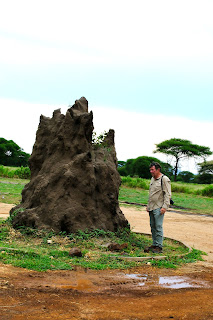Tuesday, Feb 27
A hearty breakfast and we head for the Tanzania border entry. We drive through Amboseli a bit to another gate (nice short cut) but not very many animals this way. Mt. Kilimanjaro has wrapped itself in clouds.
Another hour and a half to the border, where we are happy not to have to wait in the long line for trucks!
There are many workers here as we leave Kenya officially and then walk a few yards to enter Tanzania. Luggage is scanned and we go through several lines for health, passports and visas. The only health requirement for Tanzania is yellow fever vaccine IF you are entering from Kenya and a handful of other places. But, according to the CDC, you shouldn't get it if you are over 60, so we have a printed out and signed waiver. No one makes any comments and everyone passes through fairly quickly. A small case that Greg used to carry his passport goes missing in the scanning, but since it was empty we don't worry about it.
Our new vehicle is similar to the old and our new driver is George, who is from Tanzania.Adam says Tanzania's economy is not as good as Kenya, but here each person can get a piece of land from the government and farming is popular. We see several vehicles with animals tied to them or people on motorcycles with one person holding a sheep or goat.
KFC but no McDonalds.
We go the Sheraton Four Seasons for lunch. Very nice hotel where, we are told, both the Clintons and the O'Bamas have stayed. Nice buffet lunch. Arusha is a busy modern city known as the safari capital of Tanzania because of its proximity to the Serengeti, Tarangire and other parks.
We pass a large coffee plantation outside of Arusha, and begin to see Baobab trees. They are huge and long-lived. They hold a lot of water and their bark is used to fight fever and for other medicinal purposes. Some call it the "Tree of Life". Unfortunately when it is extremely dry the elephants eat the bark and damage the trunk. Suzy wanted to touch one so we made a quick stop by this one that George says is probably over 200 years old!
We arrive at our lodge as daylight fades, and are taken to our rooms before a 7:00 dinner. This tree hyrax who is normally nocturnal, peers at us along the trail. It looks like a rodent but is actually a close relative to the elephant!



























No comments:
Post a Comment